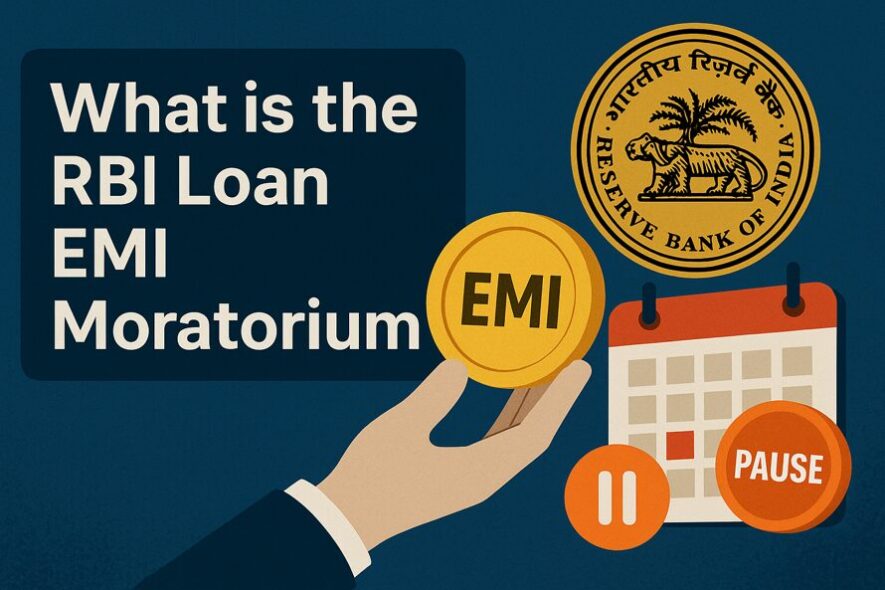
What is the RBI Loan EMI Moratorium?
Definition and Objective
An EMI Moratorium is a mechanism that pauses the scheduled repayment of loans. RBI announced a loan EMI moratorium to give relief to borrowers in difficult financial situations, like the Covid-19 pandemic. The idea here is pretty simple: to provide borrowers breathing room when the going gets tough.
This helps protect households and even business balance sheets. Moreover, it can help sustain credit discipline. Such financial support can help borrowers in times of stress.
Lenders keep the loan account active even if the borrowers do not pay the EMIs. This is done to ensure the financial security of lenders and borrowers.
Background and Historical Context
India’s banking system has managed several downcycles. The COVID-19 shock in early 2020 created a unique demand-supply freeze across services, manufacturing, and small trade.
In response, on March 27, 2020, the RBI permitted a moratorium on term loans for three months and later extended it to six months. This measure complemented fiscal steps from the government of India and liquidity actions from the central bank.
The program covered retail borrowers and enterprises, including MSMEs. Globally, several jurisdictions rolled out similar repayment pauses; India’s framework aligned with that international context while reflecting local market structure.
Applicability Across Loan Types
When RBI declared the EMI Moratorium, it was for a broad set of financial products. For example, home loans, auto loans, crop loans, personal loans, education loans, and even gold loans were covered under this scheme.
Borrowers who had sanctioned facilities as of March 1, 2020, were allowed to request deferment. Lenders would reach out to the borrowers and explain their eligibility and how they can avail themselves of this facility.
Timeline of EMI Moratorium Announcements
Initial Announcement and Extensions
RBI’s first communication on March 27, 2020, permitted a three-month pause for March–May 2020. On May 22, 2020, RBI extended the window for another three months, covering June–August 2020.
Thus, the full facility spanned March 1 through August 31, 2020. Lenders adopted standard operating procedures, built simple consent flows, and aligned auto-debit systems to reflect the deferment.
Moratorium Duration and Key Dates
- March 1, 2020: Start of the eligible period for deferment
- March 27, 2020: First RBI announcement
- May 22, 2020: Extension announced
- August 31, 2020: End of moratorium window
After the window closed, standard repayment schedules resumed, with revised tenures or adjusted EMIs based on borrower choices.
RBI Circulars and Clarifications
RBI issued multiple circulars detailing implementation, accounting treatment, provisioning, reporting to credit bureaus, and customer communication. Guidance covered working-capital interest recalculations, term-loan accruals, and disclosure of total interest impact.
Lenders published FAQs, built in-app notices, and displayed timelines to keep processes uniform and transparent.
Who Was Eligible for the EMI Moratorium?
Loans Covered: Personal, Home, Auto, Education, Business
Eligibility covered most retail term loans sanctioned before March 1, 2020. Housing finance, vehicle loans, personal loans, education finance, credit card outstanding, business term loans, and working-capital facilities fell within the scheme’s scope. Co-borrowers and guarantors remained part of the same account conditions, and joint home-loan borrowers submitted consent through their lender’s workflow.
Banks and NBFCs Offering the Moratorium
Public sector banks, private banks, regional rural banks, cooperative banks, small finance banks, and non-banking finance companies implemented the facility. Microfinance institutions adapted field processes to capture customer consent digitally or through assisted channels. Large brokerages and card issuers aligned repayment dashboards and email alerts with the moratorium’s timelines.
Criteria for Availing the Benefit
Lenders assessed accounts that were standard as of March 1, 2020. Borrowers submitted simple confirmations through net-banking, mobile apps, IVR lines, SMS links, or email forms. Many lenders enabled self-service toggles to pick months of deferment. For working-capital borrowers, lenders recalibrated drawing power and interest during the approved period and documented the approach in sanction addenda.
Impact of EMI Moratorium on Borrowers
Deferment vs Waiver: Understanding the Difference
The moratorium paused EMIs; it did not erase them. Deferred installments moved to a later date. Interest continued to apply on the outstanding principal during the deferment period.
Post-moratorium, borrowers either extended tenure, enhanced EMI amounts, or made part-payments to normalize schedules. Clarity on this distinction helped households plan for future outflows with realistic expectations.
Accrued Interest During Moratorium
Interest accrues on a daily basis. For example, a ₹30 lakh home loan at 8% per annum with a six-month pause could see incremental interest in the ₹1.1–₹1.3 lakh range, subject to exact tenure and balance at the start of deferment.
Lenders shared customized impact statements showing three choices: (1) add the accrued amount to principal and extend tenure; (2) step up EMIs; or (3) make a one-time part-payment and keep the original schedule. Business borrowers with working-capital limits received recalculated interest debits aligned to sanctioned terms.
Effect on Credit Score and CIBIL Report
RBI’s guidance preserved the credit history of borrowers who enrolled properly through lender workflows. Lenders reported these accounts as current during the deferment window.
After the window, the timely resumption of repayment sustained the borrower’s score trajectory. This approach supported borrower confidence and ensured smooth access to future credit.
How to Opt-In for the Moratorium
Application Process with Banks
The opt-in process stayed simple. Borrowers used internet banking, mobile apps, or call-center IVR to record consent. Many lenders also accept SMS replies from registered numbers. Dashboards displayed chosen months, revised tenure or EMI, and an estimate of accrued interest. For business customers, relationship managers coordinated documentation and working-capital recalibration.
Documents and Declarations Needed
Retail customers typically confirmed loan account numbers, PAN, and registered contact details. Some lenders collected short declarations describing income disruption or business impact. For businesses, lenders recorded board resolutions or proprietor confirmations, sanctioned drawing power levels, and outlined interest computation during the period.
Deadlines for Submission
Banks set operational cut-offs each month to stop auto-debits in time. Many lenders communicated reminders through push notifications, emails, and SMS. Borrowers who planned early enjoyed a smooth pause; those who chose later months selected the deferment window that matched their cash-flow cycle.
Pros and Cons of Availing the EMI Moratorium
Advantages for Financial Relief
- Immediate liquidity during income disruption
- Protection from late fees during the approved window
- Preservation of credit history when processes were followed
- Breathing space to reorganize expenses, inventory, or payroll
- Time to access emergency credit lines or government schemes
Long-Term Cost Implications
- Accrued interest increases the total outgo over the life of the loan
- Tenure extension or EMI step-up may follow post-moratorium
- Short-term comfort trades off with additional interest costs
In practice, many households viewed this as an insurance-like feature: conserve cash when income stays uncertain, and pay a measured carrying cost for that flexibility.
Case Studies: Salaried vs Self-Employed Impact
Salaried household: A dual-income family with stable employment chose a two-month pause to build a contingency fund. Post-pause, they made a small part-payment, kept the original tenure, and resumed EMIs comfortably.
Self-employed professional: A retail entrepreneur with seasonal cash flows opted for the full six months. The lender extended the tenure by seven months and scheduled a balloon part-payment in month twelve. The business stabilized, and the repayment plan stayed on track.
MSME unit: A services firm used the moratorium along with a guaranteed emergency line. The firm preserved payroll, retained clients, and returned to pre-crisis billing within two quarters.
RBI’s Guidelines for Lenders
Instructions to Banks and NBFCs
RBI advised lenders to implement uniform standards, disclose methodology for interest accrual, and communicate clearly through public notices and direct customer messaging. Lenders enhanced digital journeys for consent capture, displayed financial impact calculators, and simplified grievance channels. Supervisory guidance emphasized fair practices, transparency, and data integrity in bureau reporting.
Recovery and Restructuring Post Moratorium
After August 2020, RBI permitted a one-time restructuring window for eligible borrowers facing sustained stress. Lenders customized solutions: tenure extensions, revised EMIs, temporary rate resets, or moratorium-adjacent relief under board-approved policies.
For working-capital borrowers, lenders restored drawing power based on updated cash-flow assessments and sector outlook. This measured approach supported a broad-based recovery without undue strain on bank balance sheets.
Grievance Redressal Mechanisms
Banks set up dedicated helplines, escalation emails, and web forms for moratorium queries. Customers could approach internal nodal officers for quick resolution. If concerns persisted, the Banking Ombudsman framework offered an external route. Industry associations also circulated standard FAQs, which improved consistency across lenders and helped customers understand choices.
How to Decide Whether to Use a Moratorium (A Practical Lens)
Borrowers evaluate three quick inputs:
(1) Income visibility over the next 90–180 days;
(2) Size of emergency funds.
(3) Carrying cost of deferment.
If income timing appears uncertain, preserving cash through deferment can shield essentials like rent, utilities, payroll, and inventory. If income clarity improves, a part-payment early in the cycle reduces accrued interest. For business owners, aligning deferment with receivables cycles and supplier terms creates a smoother restart. A simple worksheet—monthly inflows, fixed outflows, EMI amount, and projected interest—delivers a clear decision path.
Practical Examples and Calculators
Home loan example
Suppose you have a home loan outstanding amount of ₹20,00,000 with a 20-year (240 months) tenure, at 8% p.a. interest. If the lender offers a 6-month moratorium (pause of EMIs), the interest accrues during those 6 months. Monthly interest = (₹20,00,000 × 8%) ÷ 12 = ₹13,333. Over 6 months, the interest is ₹80,000 (rounded off). After the moratorium ends, the outstanding amount includes this accumulated interest.
Auto loan example
Take an auto loan of ₹5,00,000 at 9% p.a. rate with 3 years (36 months) remaining. If you pause EMIs for 1 month, interest accrues on the full outstanding principal for that month. Here, interest might be ₹3,750 for that month. The lender could either extend tenure by one month or increase future EMIs slightly to cover this amount.
Many banks and NBFCs provide moratorium EMI calculators in their apps or websites (like SMFG India Credit, Federal Bank). These calculators let you input your outstanding loan amount, interest rate, tenure remaining, and the moratorium duration. The tool shows how much interest will accumulate, how much extra you will pay, and how your loan term or EMI will change.
Tips to Prepare for Future Repayment Pauses
- Maintain a three-to-six-month contingency fund in a liquid instrument
- Keep KYC and contact details updated with your lender for smooth consent flows
- Track bureau reports quarterly to ensure accurate reporting
- Use auto-debit plus calendar reminders to stay predictable post-pause
- Review insurance coverage for income protection and health events
These habits build resilience and make any future repayment flexibility easier to manage.
Conclusion
The EMI Moratorium provided a pause that protected borrowers and stabilized credit flows during an extraordinary period. By allowing temporary deferment with transparent interest treatment, the framework balanced short-term relief with long-term discipline.
Clear RBI guidance, rapid digital adoption by lenders, and proactive communication created a coordinated response across the ecosystem. For households, the lesson is enduring: build buffers, use relief tools with intent, and keep repayment plans visible and agile.
For businesses, cash-flow forecasting, disciplined collections, and early engagement with lenders create the best outcomes. As a case study in crisis finance, India’s moratorium shows how policy, platforms, and people can work together to keep the credit flywheel turning.
FAQs:
Q. What was the duration of the RBI EMI moratorium?
It lasted six months, from March 1, 2020 to August 31, 2020.
Q. Does the moratorium mean a waiver of EMIs?
No, it was a deferment, not a waiver. EMIs were postponed, not cancelled.
Q. How did the moratorium affect my loan interest?
Interest kept accruing during the pause, increasing your total repayment amount.
Q. Will the moratorium affect my credit score?
If you opted in through your bank, your credit score remained unaffected.
Q. Is the EMI moratorium still available in 2025?
No, it ended in August 2020 and is no longer active.
Q. Can I repay the deferred EMIs in one shot?
Yes, borrowers had the option to clear dues in one lump sum after the moratorium.
Q. What are the tax implications of the moratorium period?
There were no separate tax benefits for deferred EMIs. Regular rules on interest deduction under home or business loans still applied.




